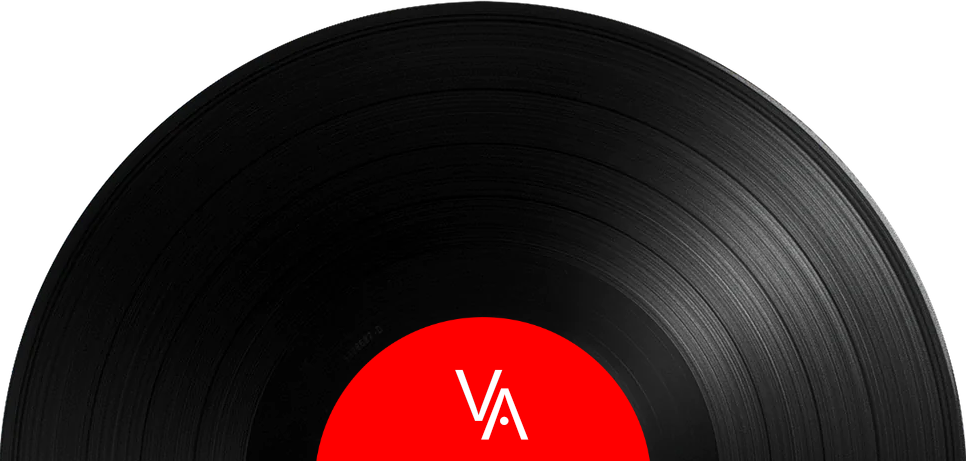I was never a big GnR fan, so I don’t know how I ended up with this record. It probably has to do with the cover. The version I have has the original album artwork, which was based on a Robert Williams’ painting called Appetite For Destruction that depicts a robotic rapist about to be punished by a metal avenger. Retailers found this image too offensive and refused to stock the album, so the artwork was changed to an image depicting a cross with skulls representing the five band members placed on it.
I probably thought it was going to be a collectible record, and it sort of is.
I was surprised at how much I liked this record as the songs made their way through the length of speaker wire and into my ears. It’s a good record, and it’s well produced for a first time effort. But it’s also very raw and sharp around the edges, and for what it’s worth I think they should have left the original cover intact. It’s just art.
Most of the songs on this LP started out as solo tracks individual members wrote on their own and brought to the band for completion. By the time they were committed to tape, after having been refined live on stage as the band made their way through the L.A. club circuit, they were solid tunes and the boys were able to play them confidently. That confidence oozes from the speakers.
One day, as Axl Rose was screwing a cute nineteen-year-old stripper named Adriana Smith in the recording studio, the tape was rolling. Adriana also just happened to be Steven Adler's - Guns n' Roses' then drummer - girlfriend. Smith wanted to get back at Adler for cheating on her.
“Come on, Adriana, make it real,” Rose said. “Stop faking!”
Engineer Vic Deyglio had set up a microphone to capture the sounds of Rose and Smith having sex. Although she was drunk, Smith eventually gave Rose what he wanted and the resulting moans ended up on the song Rocket Queen, Appetite For Destruction‘s side two closer. Smith instantly became a rock n' roll legend, but has since expressed regret over her contribution.
But that was Guns n' Roses and in their world this wasn't anything out of the ordinary. “It was just hard-core good times,” said guitarist Slash.
Released in July, 1987, Appetite for Destruction went on to sell more than 15 million copies and became one of the best-selling debut LPs ever. It is also one of the most critically acclaimed metal records, and one of the last rock recordings to be mastered specifically with vinyl in mind. “We used classic instruments and classic amps,” says producer Mike Clink. It was edited using a razor blade to slice and splice the two-inch tape it had been recorded onto.
Guns n' Roses imagined themselves as reviving rock’s rebel spirit. “Rock & roll in general has sucked a big dick since the Sex Pistols,” guitarist Izzy Stradlin told Rolling Stone, in 1988.
By the end of 1986 Guns n’ Roses had yet to play their first stadium show, but they could still create a spectacle. Broke and strung out on drugs they released their frustration on the house they were renting, which just happened to be the former estate of Cecil B. DeMille. The landlord summoned the band’s A&R rep, Tom Zutaut, and manager Arnold Stiefel, to the property.
“I almost fainted,” says Stiefel, whose name was on the lease. “It was Beneath the Planet of the Apes. It was so beyond imagining. I couldn’t stop laughing.” The band had ripped toilets from the floor and thrown them out the window. The scene inside was worse. “People were defecating in the sinks," Zutaut remembered. "The holes in the floor where the toilets got ripped off were filled with urine. There were half-eaten Whoppers with mold on the wrappers. They would get in these drug rages and just go berserk.”
But one room was left untouched. “You go inside and there was Axl in this immaculate, perfect room, surrounded by all this squalor," Zutaut said.
The damage amounted to $22,000. It was paid, and Zutaut and Stiefel then dropped Guns n' Roses as clients.
The classic Guns n’ Roses lineup came together for its first rehearsal in May, 1985. “The moment that we fuckin’ slammed into our first chord, there was something there and we all knew it,” says McKagan. “It felt like, ‘This is the band, this is it. This is what we’ve all been searching for.'”
The band signed to Geffen in 1986 and this record surfaced a year later. The total budget was about $370,000, which was an extravagant amount for the time, especially for a debut record from an unknown band. Five months after its release Appetite for Destruction had sold about 200,000 copies. Then a video for Welcome to the Jungle ended up on MTV and the next day it was as if every kid in America went to the mall and bought a copy.
Slash is comfortable with the legacy of Appetite for Destruction. “When I was a kid, there were these be-with-you-forever albums that represented something in your life.” he says. “Whether it was the background music of your childhood or your puberty or whatever. Dark Side of the Moon or Sticky Fingers or Aerosmith’s Rocks or Led Zeppelin IV. And we made one of those records, which is all I could ever have asked for. It gives me goose bumps. That’s something no one ever can take away from me.”
I was never a big GnR fan, so I don’t know how I ended up with this record. It probably has to do with the cover. The version I have has the original album artwork, which was based on a Robert Williams’ painting called Appetite For Destruction that depicts a robotic rapist about to be punished by a metal avenger. Retailers found this image too offensive and refused to stock the album, so the artwork was changed to an image depicting a cross with skulls representing the five band members placed on it.
I probably thought it was going to be a collectible record, and it sort of is.
I was surprised at how much I liked this record as the songs made their way through the length of speaker wire and into my ears. It’s a good record, and it’s well produced for a first time effort. But it’s also very raw and sharp around the edges, and for what it’s worth I think they should have left the original cover intact. It’s just art.
Most of the songs on this LP started out as solo tracks individual members wrote on their own and brought to the band for completion. By the time they were committed to tape, after having been refined live on stage as the band made their way through the L.A. club circuit, they were solid tunes and the boys were able to play them confidently. That confidence oozes from the speakers.
One day, as Axl Rose was screwing a cute nineteen-year-old stripper named Adriana Smith in the recording studio, the tape was rolling. Adriana also just happened to be Steven Adler's - Guns n' Roses' then drummer - girlfriend. Smith wanted to get back at Adler for cheating on her.
“Come on, Adriana, make it real,” Rose said. “Stop faking!”
Engineer Vic Deyglio had set up a microphone to capture the sounds of Rose and Smith having sex. Although she was drunk, Smith eventually gave Rose what he wanted and the resulting moans ended up on the song Rocket Queen, Appetite For Destruction‘s side two closer. Smith instantly became a rock n' roll legend, but has since expressed regret over her contribution.
But that was Guns n' Roses and in their world this wasn't anything out of the ordinary. “It was just hard-core good times,” said guitarist Slash.
Released in July, 1987, Appetite for Destruction went on to sell more than 15 million copies and became one of the best-selling debut LPs ever. It is also one of the most critically acclaimed metal records, and one of the last rock recordings to be mastered specifically with vinyl in mind. “We used classic instruments and classic amps,” says producer Mike Clink. It was edited using a razor blade to slice and splice the two-inch tape it had been recorded onto.
Guns n' Roses imagined themselves as reviving rock’s rebel spirit. “Rock & roll in general has sucked a big dick since the Sex Pistols,” guitarist Izzy Stradlin told Rolling Stone, in 1988.
By the end of 1986 Guns n’ Roses had yet to play their first stadium show, but they could still create a spectacle. Broke and strung out on drugs they released their frustration on the house they were renting, which just happened to be the former estate of Cecil B. DeMille. The landlord summoned the band’s A&R rep, Tom Zutaut, and manager Arnold Stiefel, to the property.
“I almost fainted,” says Stiefel, whose name was on the lease. “It was Beneath the Planet of the Apes. It was so beyond imagining. I couldn’t stop laughing.” The band had ripped toilets from the floor and thrown them out the window. The scene inside was worse. “People were defecating in the sinks," Zutaut remembered. "The holes in the floor where the toilets got ripped off were filled with urine. There were half-eaten Whoppers with mold on the wrappers. They would get in these drug rages and just go berserk.”
But one room was left untouched. “You go inside and there was Axl in this immaculate, perfect room, surrounded by all this squalor," Zutaut said.
The damage amounted to $22,000. It was paid, and Zutaut and Stiefel then dropped Guns n' Roses as clients.
The classic Guns n’ Roses lineup came together for its first rehearsal in May, 1985. “The moment that we fuckin’ slammed into our first chord, there was something there and we all knew it,” says McKagan. “It felt like, ‘This is the band, this is it. This is what we’ve all been searching for.'”
The band signed to Geffen in 1986 and this record surfaced a year later. The total budget was about $370,000, which was an extravagant amount for the time, especially for a debut record from an unknown band. Five months after its release Appetite for Destruction had sold about 200,000 copies. Then a video for Welcome to the Jungle ended up on MTV and the next day it was as if every kid in America went to the mall and bought a copy.
Slash is comfortable with the legacy of Appetite for Destruction. “When I was a kid, there were these be-with-you-forever albums that represented something in your life.” he says. “Whether it was the background music of your childhood or your puberty or whatever. Dark Side of the Moon or Sticky Fingers or Aerosmith’s Rocks or Led Zeppelin IV. And we made one of those records, which is all I could ever have asked for. It gives me goose bumps. That’s something no one ever can take away from me.”



